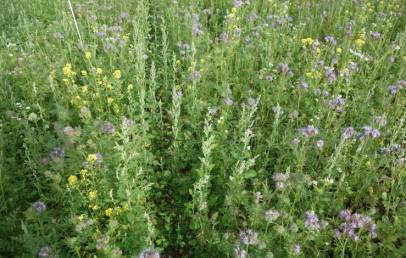The following post previews the research that will be presented at the Meeting, held virtually as SciCon (3–7 May 2020).
A guest post by Verena Sesin, Steering Committee member of the SETAC Global Plants Interest Group
From our backyards, to parks, nature areas, and agriculture – plants surround us! We often forget that plants not only look pretty, but they are also vital for our daily lives. Plants are key parts of aquatic and terrestrial ecosystems. In rivers, wetlands, grasslands, forests, agricultural fields, and various other habitats, plants provide shelter and food for many animals, from tiny microbes and invertebrates, to large mammals – including us humans. And, don’t forget, plants use the light energy from the sun to produce macromolecules and oxygen – a very special skill that supports all life on our planet.

Terrestrial plant community growing in a field in Germany (courtesy of Rena Isemer, Bayer AG)
Plants are threatened by chemicals and other stressors
Because plant communities are such key structural and functional components of our environment, we need to protect them from potential threats to their health, survival, and diversity. In both aquatic and terrestrial ecosystems, plants may be at risk from several stressors, including different chemicals, pesticides, pharmaceuticals, heavy metals, or nanomaterials. These stressors are often human-caused and can be present in water, soil, or air. In order to understand potential impacts of these stressors on plants and to support risk assessments, scientists around the world perform studies in aquatic and terrestrial plant ecology and ecotoxicology.
What we need to know to protect plants
Scientists have lots of questions about how plants respond to different stressors, and how we can best measure their responses for risk assessment. For example, scientists are wondering:
- How do plant community composition and dynamics change following exposure to stressors?
- How can we design standardized tests that measure impacts on plants and generate data that can be used for risk assessment?
- How can we evaluate the potential of plants to recover from adverse impacts?
- How can we use plants in buffer zones or artificial wetlands to mitigate exposure of the environment and improve water quality?
- How can we best control invasive plants and use reported control efficacy to inform risk assessments?
The goal of answering these questions is to provide guidance for the risk assessment of pesticides and other chemicals, and to develop adequate test methods for assessing stressors’ effects on aquatic and terrestrial plants.

Glyceria maxima plants cultured in a growth chamber (courtesy of Toxi-Coop)
Together, let’s ensure that plants are protected
Are you interested in finding out more? Then join the . Our group aims to bring together everyone that is interested in plant ecology, ecotoxicology, risk assessment and management. We are open to all scientists and students! We provide a forum for scientific discussion and collaboration among academia, business and government. In this role, we organize sessions and meetings at the SETAC conferences, and we organize or support workshops on specific topics related to chemical risk assessment and management of plants. Within the group, we build temporary working groups on defined tasks, such as the development of new test guidelines.
Join us at SETAC SciCon
Session presentations: Our session “Aquatic and Terrestrial Plant Ecology, Ecotoxicology and Risk Assessment” (2.01) features four platform and sixteen poster presentations on the latest findings in plant ecotoxicology, novel testing methods and guidelines. All contributions can be viewed on demand throughout the conference from 3–7 May as well as in the month thereafter by registered participants.
Live discussion: Registered participants can join the conversation on the presented research in our live discussion session on Wednesday, 6 May, 13:45–14:30 UTC.
Open meeting: Get to know how our group works and what we are up to. Our open meeting is on Wednesday, 6 May, 14:45–16:15 UTC. We have many ongoing projects related to plant ecotoxicology and risk assessment. For example, current projects are to develop a new test guideline with the aquatic plant Glyceria, and to develop a toxicokinetic-toxicodynamic model for the aquatic plant Lemna. We are open for new working groups; feel free to make suggestions.
Bonus: Everyone, whether registered for the SETAC SciCon meeting or not, can participate in our open meeting!
To join our virtual open meeting, you need to join the . A link to the virtual meeting will be provided to all members.
